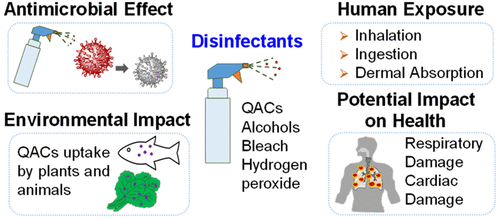当前位置:
X-MOL 学术
›
ACS Chem. Health Saf.
›
论文详情
Our official English website, www.x-mol.net, welcomes your feedback! (Note: you will need to create a separate account there.)
Increased Use of Disinfectants During the COVID-19 Pandemic and Its Potential Impacts on Health and Safety
ACS Chemical Health & Safety Pub Date : 2021-08-25 , DOI: 10.1021/acs.chas.1c00026 Hannah M. Dewey 1 , Jaron M. Jones 1 , Mike R. Keating 1 , Januka Budhathoki-Uprety 1
ACS Chemical Health & Safety Pub Date : 2021-08-25 , DOI: 10.1021/acs.chas.1c00026 Hannah M. Dewey 1 , Jaron M. Jones 1 , Mike R. Keating 1 , Januka Budhathoki-Uprety 1
Affiliation

|
The COVID-19 pandemic has called for the increased use of disinfectants worldwide in public facilities, transportation, hospitals, nursing homes, wastewater treatment facilities, and even common households to mitigate virus burden. Active ingredients in common disinfectants recommended for use against COVID-19 viruses include chemicals such as quaternary ammonium compounds (QACs), hydrogen peroxide, bleach (sodium hypochlorite), and alcohols. These disinfecting chemicals differ in their structures, properties, modes of action, environmental behaviors, and effects on human health upon exposure. Humans can be exposed to disinfecting chemicals mainly through dermal absorption, inhalation, and ingestion. The total exposure and relative contribution of each exposure route vary considerably among the disinfectants. QACs have been linked to occupational illnesses such as asthma and an increased risk of chronic obstructive pulmonary disease (COPD), whereas excess use of bleach, hydrogen peroxide, or alcohol-based disinfectants can cause respiratory damage and has been linked to an increased risk of developing and controlling asthma. Recent studies showed that the presence of QACs in human blood has been associated with changes in health biomarkers such as an increase in inflammatory cytokines, decreased mitochondrial function, and disruption of cholesterol homeostasis in a dose-dependent manner. Therefore, repeated human exposure to disinfectants during the pandemic has raised questions on exposure-related long-term health risks and occupational safety. Furthermore, in lieu of a lack of adequate knowledge and public awareness, these chemicals have been frequently used on porous surfaces, including fabrics/textiles and consumer plastics and even for disinfecting cloth facemasks, on which disinfectant chemical residues may persist for longer duration, causing potential degradation of plastic materials, releasing additives, and shedding microplastics. In addition, the increased use of these disinfectant chemicals and the subsequent discharge into wastewater may cause adverse impacts on aquatic ecosystems, accumulation on vegetables, and contamination of the food chain via wastewater irrigation and sludge application. This article provides a well-rounded understanding of the most common disinfectants and reviews modes of action of those disinfectants, their interactions with aquatic and terrestrial environments, the exposure to humans, and potential impacts to human health and safety.
中文翻译:

在 COVID-19 大流行期间增加使用消毒剂及其对健康和安全的潜在影响
COVID-19 大流行要求在全球公共设施、交通、医院、疗养院、废水处理设施甚至普通家庭中增加使用消毒剂,以减轻病毒负担。推荐用于对抗 COVID-19 病毒的常见消毒剂中的活性成分包括化学物质,例如季铵化合物 (QAC)、过氧化氢、漂白剂(次氯酸钠)和酒精。这些消毒化学品的结构、特性、作用方式、环境行为以及暴露后对人类健康的影响各不相同。人类主要通过皮肤吸收、吸入和摄入接触消毒化学品。每种接触途径的总接触量和相对贡献因消毒剂而异。QAC 与哮喘等职业病和慢性阻塞性肺病 (COPD) 风险增加有关,而过度使用漂白剂、过氧化氢或酒精类消毒剂会导致呼吸道损伤,并与增加患慢性阻塞性肺病 (COPD) 的风险有关。发展和控制哮喘。最近的研究表明,人体血液中 QAC 的存在与健康生物标志物的变化有关,例如炎症细胞因子的增加、线粒体功能的降低和胆固醇稳态的破坏,这些都是剂量依赖性的。因此,在大流行期间,人类反复接触消毒剂,引发了与接触相关的长期健康风险和职业安全的问题。此外,代替缺乏足够的知识和公众意识,这些化学物质经常用于多孔表面,包括织物/纺织品和消费塑料,甚至用于消毒布制面罩,消毒剂化学残留物可能会持续较长时间,导致塑料材料潜在降解、释放添加剂和脱落微塑料。此外,这些消毒剂化学品的使用增加以及随后排放到废水中可能会对水生生态系统造成不利影响、蔬菜上的积聚以及废水灌溉和污泥应用对食物链的污染。本文全面介绍了最常见的消毒剂,并回顾了这些消毒剂的作用方式、它们与水生和陆地环境的相互作用、与人类的接触、
更新日期:2021-08-25
中文翻译:

在 COVID-19 大流行期间增加使用消毒剂及其对健康和安全的潜在影响
COVID-19 大流行要求在全球公共设施、交通、医院、疗养院、废水处理设施甚至普通家庭中增加使用消毒剂,以减轻病毒负担。推荐用于对抗 COVID-19 病毒的常见消毒剂中的活性成分包括化学物质,例如季铵化合物 (QAC)、过氧化氢、漂白剂(次氯酸钠)和酒精。这些消毒化学品的结构、特性、作用方式、环境行为以及暴露后对人类健康的影响各不相同。人类主要通过皮肤吸收、吸入和摄入接触消毒化学品。每种接触途径的总接触量和相对贡献因消毒剂而异。QAC 与哮喘等职业病和慢性阻塞性肺病 (COPD) 风险增加有关,而过度使用漂白剂、过氧化氢或酒精类消毒剂会导致呼吸道损伤,并与增加患慢性阻塞性肺病 (COPD) 的风险有关。发展和控制哮喘。最近的研究表明,人体血液中 QAC 的存在与健康生物标志物的变化有关,例如炎症细胞因子的增加、线粒体功能的降低和胆固醇稳态的破坏,这些都是剂量依赖性的。因此,在大流行期间,人类反复接触消毒剂,引发了与接触相关的长期健康风险和职业安全的问题。此外,代替缺乏足够的知识和公众意识,这些化学物质经常用于多孔表面,包括织物/纺织品和消费塑料,甚至用于消毒布制面罩,消毒剂化学残留物可能会持续较长时间,导致塑料材料潜在降解、释放添加剂和脱落微塑料。此外,这些消毒剂化学品的使用增加以及随后排放到废水中可能会对水生生态系统造成不利影响、蔬菜上的积聚以及废水灌溉和污泥应用对食物链的污染。本文全面介绍了最常见的消毒剂,并回顾了这些消毒剂的作用方式、它们与水生和陆地环境的相互作用、与人类的接触、



























 京公网安备 11010802027423号
京公网安备 11010802027423号